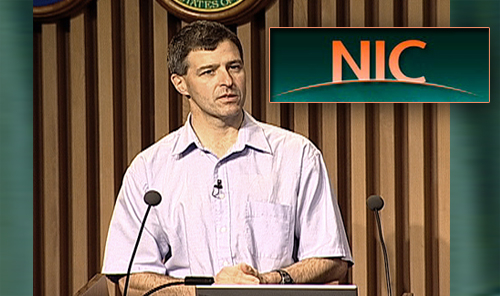Seeking the sphere of perfect compression
 (Download Image)
Video image by Bob Hirschfeld/NEWSLINE John Edwards
(Download Image)
Video image by Bob Hirschfeld/NEWSLINE John Edwards
The National Ignition Facility (NIF) scientist responsible for upcoming ignition experiments detailed progress being made by his team, in the final of five seminars devoted to the National Ignition Campaign, NIF's program of experiments leading to the ultimate goal of fusion ignition.
John Edwards described the complex physics and engineering involved in creating the NIF hydrogen-filled targets.
For one thing, the target is incredibly small to begin with, only about two millimeters in diameter.
It needs to be filled with frozen hydrogen fuel, which will implode and ignite after NIF's 192 laser beams illuminate the gold canister that contains the target, known as a hohlraum.
Edwards compared the implosion as similar to compressing a basketball to the size of a pea in one microsecond, while keeping it perfectly round with a surface roughness of no more than one micron.
But just compressing the target won't achieve ignition, said Edwards.
"We're going to accelerate this target to close to one million miles an hour and push it with about 100 million atmospheres. So you can't just do that straight off. You have to do it very carefully," he said.
Although it's important that all the lasers are outputting the proper amount of energy, if the target is illuminated too quickly, the hydrogen fuel won't react properly.
And the energy in each beam must be precisely controlled so that the compression will be perfectly spherical.
For the next year and a half or so, NIF researchers will be fine-tuning various parameters to adjust the laser beams and the targets.
Adjustments are made using a variety of measurement techniques with six surrogate targets and different diagnostics. One is called a keyhole target, in which a "radar gun" is pointed into a tiny window in the hohlraum wall. The targets also will be filled with a different mixture of fuel, allowing better measurements.
Before starting actual experiments, teams have been conducting simulated campaigns, to practice and improve processes and team interactions.
Edwards said the so-called SimCams are designed to enable them to "transition naturally and seamlessly into experiments. Only the target performance is simulated, everything else occurs realistically. The SimCams will progressively integrate more real capability and performance in the run up to ignition experiments."




